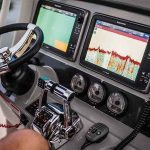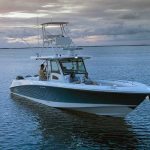When locking through, always follow the directions of the lockmaster. He or she probably has far more experience than you do in matters of lock space management, hydraulics, and conditions affecting safe and efficient lockage.
Before entering the lock, all passengers on deck during lockage should don PFD’s, and any passenger with duties should be briefed. Fenders should be positioned to prevent damage from the lock wall and other boats.
Don’t approach the lock beyond the stand-off distance restriction, usually posted in the waiting pattern area. Be cautious about drifting into any adjacent dam or spillway areas while awaiting entry to the lock.
When instructed or signalled to do so, enter the locks slowly and position your boat in accordance with lockmaster instructions. Unless instructed otherwise, DO NOT TIE UP TO THE LOCK WALL OR TO ANY LADDERS, HANDHOLDS, OR OTHER LOCK HARDWARE.
When positioned on the lock wall, use boathooks to keep your boat parallel to the lock wall from bow and stern, and hold onto the lines, chains, sideboards, or whatever other lock structures or equipment is provided for that purpose.
Turn the volume off on radios or other audio devices so that instructions can be heard and understood easily. Turn your engine OFF, and extinguish all smoking materials.
When the lockage is complete, comply with the lockmaster instructions on departing the lock. At your turn, depart at a slow speed until well clear of the lock extension wall.
Horn signals upon entry or departure are usually not required for recreational boaters, but if they are required where you boat, use them. It’s also generally considered to be a courtesy to sound one short blast as you clear the locks.








